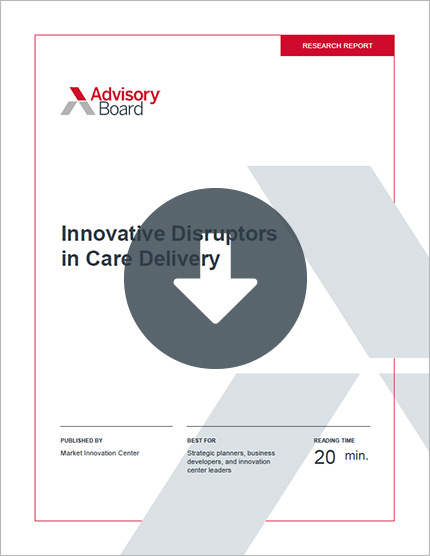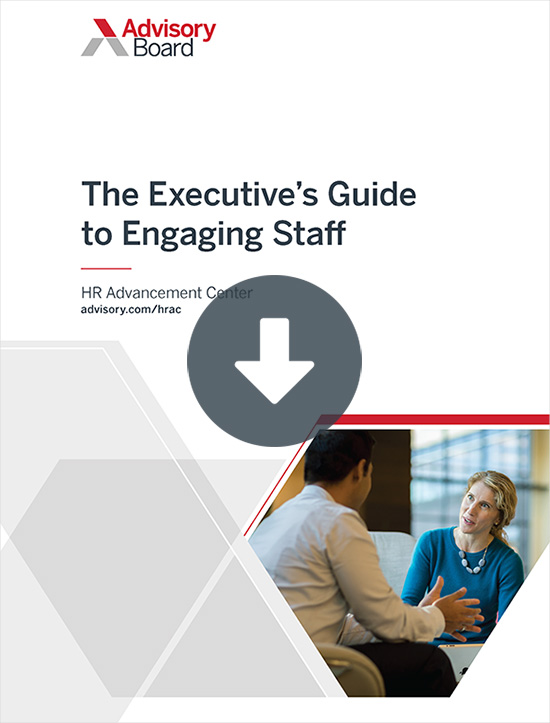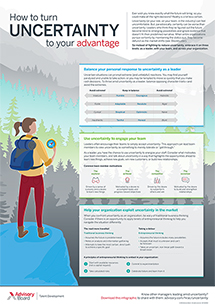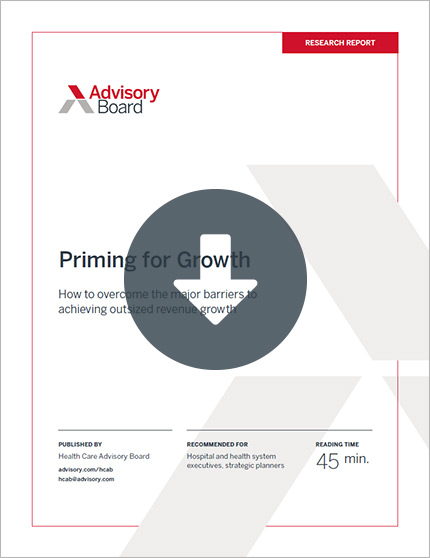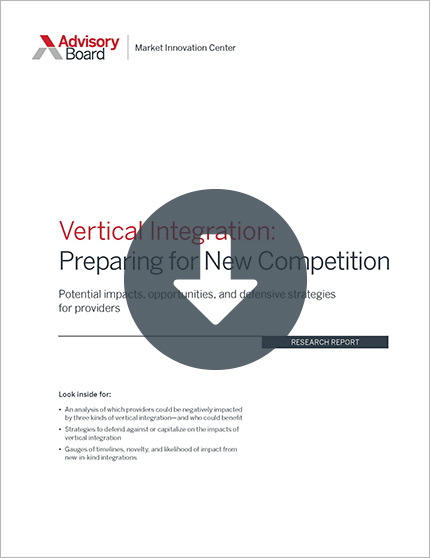Auto logout in seconds.
Continue LogoutWelcome to the "Lessons from the C-suite" series, featuring Advisory Board President Eric Larsen's conversations with the most influential leaders in health care.
In this edition, Tom Mihaljevic, president and CEO of Cleveland Clinic, talks about the extraordinary circumstances that took him from Croatia to the Clinic's C-suite, his view on growth as an "ethical responsibility," and why you should call your mother every day.
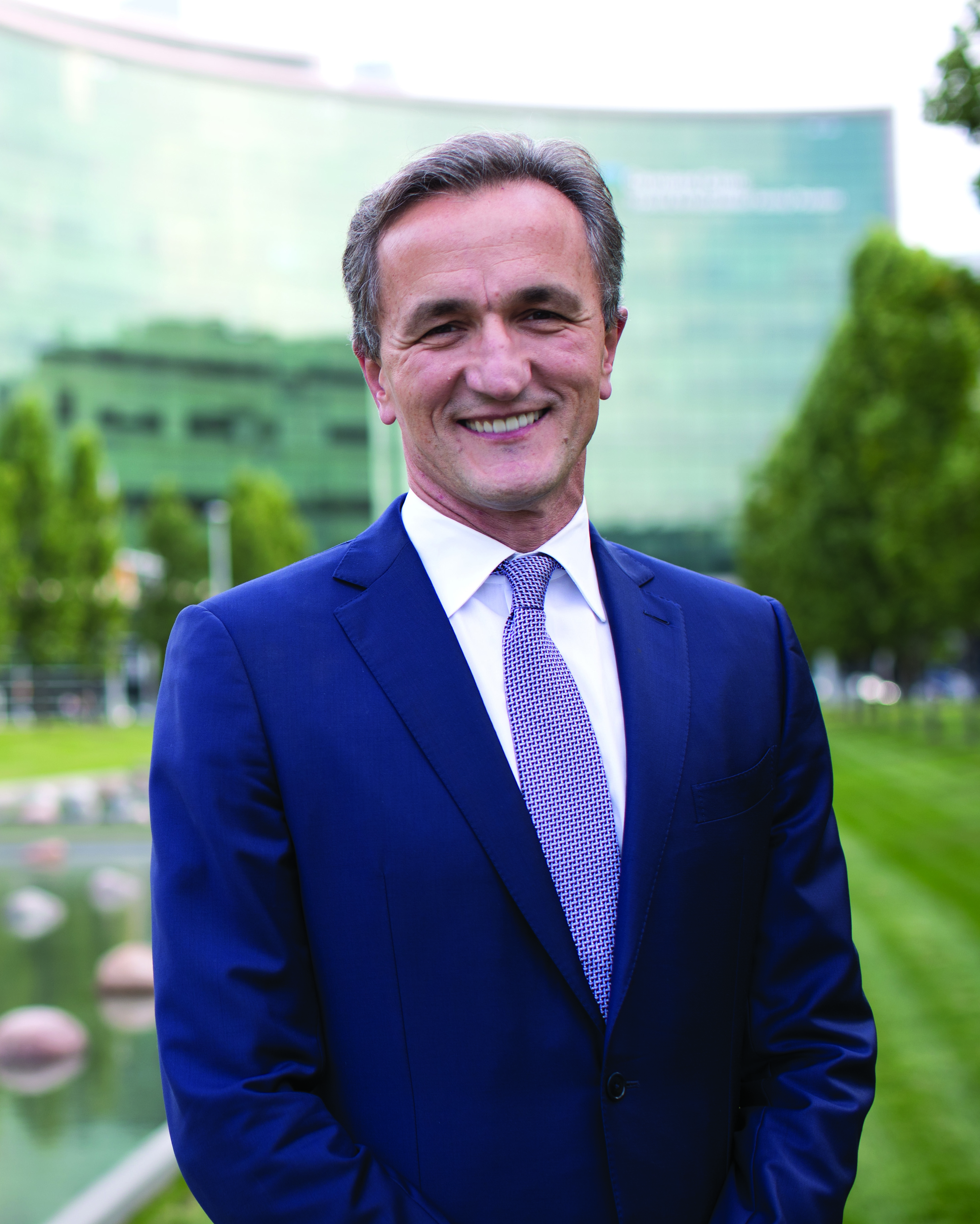
Tom Mihaljevic, president and CEO of Cleveland Clinic
Charting a career from Croatia to Cleveland
Question: Tom, of course I want to talk about your experiences as CEO of the $10 billion Cleveland Clinic, one of health care's truly iconic names, but first I have to clear something up: I've always called you "Tommy," but I also hear 'Tom' as well—do you have a preference?
Tomislav Mihaljevic: Eric, I don't mind either way, quite frankly. Most people use Tom now, but it's Tommy for my mom and people who've known me for a long time.
It's a funny story, actually. When I got my job, everybody used to call me Tommy since my real first name, Tomislav, is just too complicated. So Toby [Cosgrove, former Cleveland Clinic president and CEO] came to me and said, "Listen, we have to make a big decision. What do you want to be called?" And I said, "What do you mean? I have a name. I know I got a new job, but my parents decided on my name a long time ago." And Toby said, "It can't be Tommy. We have to formalize it more. It's going to be Tom."
Q: And Toby can speak with unique authority on this because nobody calls him by his given name, Delos. But back to you—you've taken this fascinating path from Croatia to Washington D.C, to Austria, to Switzerland, to Boston, to Cleveland, to Abu Dhabi, and now back to Cleveland. I'd love to hear your thoughts on this remarkable journey.
Mihaljevic: For me, a lot that happened is just a result of circumstance. I was born and raised during Communist times in Zagreb, Croatia, in a country that was Yugoslavia at that time. I had a loving family, but it was a very modest childhood: My parents, my sister, and I all lived in a one-bedroom apartment, and my grandfather would spend winters with us. So pretty much throughout my childhood, there were three or four of us sleeping in the same room. And when I went to the grocery store each day, I would go with exactly enough money to buy a quarter gallon of milk and a half a loaf of bread—not an entire loaf of bread, because you can't use an entire loaf and it would go foul. I didn't taste butter until I was probably 10, because margarine was much less expensive.
But this is not so fascinating, because the entire country, all the people I knew, grew up exactly in the same way—it wasn't a deviation from the norm back then. What makes it interesting is that we all establish a foundation or a baseline in life of how things look, and we compare all our subsequent experiences and accomplishments against that baseline. And I think my experiences sets a pretty healthy baseline; it makes me grateful for whatever gifts I may receive.
And like I said, I had a loving family; I'm still very close to my sister, and I call my mom, who's still in Zagreb, every day.
Q: Well, now I feel guilty. I need to start calling mom more regularly.
Mihaljevic: You should, Eric. It's a five-minute effort, no excuse. Just pick up your phone and call. You just say, "Hey, how are you?" It's something that I learned over time.
Q: And how did you get from Croatia to Switzerland? When did you leave?
Mihaljevic: After I graduated from med school in 1989, I did some research at the Department of Anatomy, which actually led to me spending a summer doing research in Washington, D.C. The experience helped me realize that I wanted to pursue a clinical career—not research—but when I came back to Croatia, there was no path forward for me. The war had started in 1991, and everything was closed. There were no training positions.
While doing some other work, I volunteered at a small hospital in Zagreb. I actually ran into Marko Turina—a renowned heart surgeon, retired now, who ran the Department of Cardiac Surgery in Zurich, Switzerland—in the parking lot of a local hospital. Marko was actually of Croatian origin, and he was visiting his mother there. And while we were walking in the parking lot, he asked if I would like to come for a year to do research at the University Hospital of Zurich. I said, "Of course." He said, "Do you speak German?" "No." And he asked, "How much time do you need to learn German?"
Re-ignite the growth engine: 3-part report series
How do you answer that question, right? To learn a brand-new language well enough to practice medicine in a different country? I said, "I need a year." He said, "If you cannot do it in three months, there is nothing to talk about." So I said, "Okay, I'll do it in three months." So I dropped everything and moved in with my cousin, who lived in Vienna, while I learned German.
Q: So you went from having no exposure to German to achieving proficiency in three months?
Mihaljevic: My German actually was way better than my English is currently.
Q: That's outstanding. Three months of study, and then you went to Zurich?
Mihaljevic: Yeah, but you know, they speak a different German in Zurich than they speak in Germany—Switzerdeutch, which I had to learn later. I ended up staying for four years. But there were very limited formal educational opportunities in Switzerland, because as a foreigner, I wasn't allowed in any residency programs.
However, my mentor in Switzerland knew someone at Brigham and Women's Hospital who invited me to spend a year there. Now, I was 31 years old, a medical school graduate with nothing to show for it—I mean, I had five or six years of postgraduate training, but I didn't have a residency, a job, or a profession—so I decided to try it.
Q: Atul Gawande was your chief resident at Brigham and Women's. Atul tells a fun story—you were a full surgeon at the time, and evidently, when there was a gunshot wound or something serious in the ER, they'd call up Atul and ask, "Hey, can we have Tommy?" And Atul would say, "Sure, you can take my intern."
Mihaljevic: That was a great experience. I immediately recognized how wonderful it is to be in the United States; the educational opportunities here were unparalleled, and people are so kind and supportive. I applied for Brigham's residency program and became the first foreign medical graduate accepted as an intern at Brigham. I stayed there for my entire residency, plus my cardiac surgical residency and two years on staff before Toby recruited me to Cleveland Clinic.
'The phase of the mouse'
Q: This is a good segue, Tom, because I'd like to talk about your very first visit to the Clinic. I understand that a PA was walking with you through Cleveland Clinic's Skyway to visit Toby, and on the way, he spotted a patient who was clearly lost. And the PA just said to you, "Please wait here," and spent the next 10 minutes taking this patient where she needed to go. You've said this was a quintessential Cleveland Clinic "moment" for you.
Mihaljevic: Yeah, that was very revealing. I don't know how to describe it, but I think whenever you meet a person or organization, you're consciously or subconsciously absorbing hints of what the culture looks like, and that helps you identify whether you feel comfortable in that environment. And at Cleveland Clinic, I immediately felt very, very comfortable. This was a PA; he wasn't a department chair, not someone who's actively trying to recruit me. He was just a person who loved his job. So it demonstrated how far the culture permeated the organization.
Q: Let's fast-forward from that first "wow moment" to the next chapter of your Cleveland Clinic career—an incredibly prolific seven years during which you performed 4,000 cardiothoracic procedures and somehow shoehorned in enough time to publish 140 peer-reviewed articles.
Mihaljevic: I don't really know what the exact number of procedures was; I never counted, but I worked as hard as I could. At Cleveland Clinic, Toby and his predecessors established a very unusual practice pattern so each one of us operated every day. So we'd come to work, we'd go to the operating room, and we'd plan everything else around this. That's how you get good at what you do.
Q: You then transitioned from your surgical role in Cleveland to an administrative role in Abu Dhabi, and now ultimately to CEO of the enterprise. Before we talk about that career evolution, I have to wonder about your reflections on leaving clinical practice. I can imagine that when you were under consideration for the CEO post, you probably had a moment while performing surgery when you thought, "This could be the last one."
Mihaljevic: You know, Eric, while surgery was very important for me, I realized when I reached my late 40s that I'd done what I'd wanted—I'd become a really good heart surgeon, published, developed a large practice—and my interests had evolved. So I told Toby that I was ready for a new challenge.
And Toby deserves great credit here, because he realized that it's very difficult to jump from the operating room to the board room and be effective in that new position. So what he did for me and many others, and what we continue to do today, is institute a gradual transition from a clinical role to the more managerial executive role. And for me, that transition took place in Abu Dhabi, where I progressed over about seven years from chief of staff to CEO. And while my job now has a different scope and a different environment, the experience of being in a boardroom, being an executive, and running an organization isn't new.
Q: Do you miss surgery?
Mihaljevic: People often ask me that. For me, taking care of the patient is the primary focus and transitioning from surgeon to executive allows me to accomplish that at a broader level. Being a surgeon was an important part of my development, but taking care of the patient means fully embracing one responsibility, and right now, the responsibility I carry for Cleveland Clinic is that of CEO.
Q: What was the shift like, when you moved from CEO at Abu Dhabi to Cleveland Clinic CEO?
Mihaljevic: During a time like this, when the organization and individual are most vulnerable, I think the support of the outgoing person and a carefully crafted transition period are essential. And at Cleveland Clinic, people are very passionate about the enterprise; there's a healthy dose of selflessness in every person. Toby really embodies it quite well—for him, it was never about Toby, it was always about Cleveland Clinic, so he wanted to make the transition as smooth as possible. So when I got the job, I immediately came back to Cleveland and spent four months with Toby for what I jokingly called, "the phase of the mouse."
Q: The "phase of the mouse"?
Mihaljevic: Yeah. It's when you have small mouth and big ears; you don't talk much but you listen a lot. And during the phase of the mouse, I tagged along with Toby as he introduced me in countless different venues throughout the organization—we traveled to London, to Abu Dhabi, to all of our Florida facilities; we went through every one of our hospitals. Because Toby wanted to make sure that he transferred as much knowledge as possible over that time period, for which I'm forever grateful. And after that, Toby maintained a full advisory capacity for a year, and he continues to be in an advisory capacity to this date. So we were in frequent contact.
Abu Dhabi, London, and international expansion
Q: Tom, I'd like to ask about the Clinic's international strategy. You are increasingly covering lots of spots on the global map—Abu Dhabi, of course; your consultative relationship with Luye Medical Group in Shanghai; and arguably most importantly, you are nearing completion of Cleveland Clinic London. What is the animating strategy here for your international work? How are you extrapolating the lessons learned in Abu Dhabi to your new projects?
Mihaljevic: I'll start with some observations on Abu Dhabi. I think there's one really important feature for Cleveland Clinic Abu Dhabi that distinguishes it from most other American hospitals' international forays, and that's our decision to make it a real Cleveland Clinic. Let me explain: Nowadays, you can travel the world without ever leaving the United States; you can fly in an American plane, stay in American hotels, eat American food, use American gadgets. But there are two notable exceptions to this: We've never been able to export America's excellence in health care or higher education.
So if you take that as the baseline, Cleveland Clinic Abu Dhabi is the first truly American hospital outside of the United States. It's operated by clinical and administrative leaders who came from, or who have spent time at, Cleveland Clinic. We have the same processes of care, the same EHR system, and a healthy exchange of practices and people. So we can ensure the quality and experience of care at Cleveland Clinic Abu Dhabi matches or exceeds the care quality at all our hospitals. And that's really important for us. We didn't want to put a name on the building; we wanted to create a true Cleveland Clinic in Abu Dhabi. And we're all in; we don't have a fly-by sentiment in anything that we do—that's been an MO of Cleveland Clinic ever since our inception.
We learned a lot in the process of establishing Cleveland Clinic Abu Dhabi. We've benefited immensely from the talent of people working in the U.A.E., particularly that of our partners in this project, Mubadala. In fact, I think finding the right partner is one of the most important determinants of success in our international business ventures. Because it would be extremely difficult to navigate the intricacies of health care markets in different countries without having someone on the ground who really understands the country well.
Q: I'd like to jump a bit out of chronological career order, and rewind for a second—when you spoke to Toby about figuring out your next steps in your career, was Abu Dhabi on your mind, or was it Toby's idea?
Mihaljevic: I approached Toby several months before he asked me about the job in Abu Dhabi, he had just recruited Marc [Harrison, former CEO of Cleveland Clinic Abu Dhabi and current president and CEO of Intermountain], both of us moved there around the same time. I took over as CEO after Marc left for Intermountain, right as the hospital opened.
I knew I wanted to advance my career. I was ready to take on new challenges and this opportunity presented itself. I embraced it.
Q: It sounds incredibly adventurous.
Mihaljevic: I saw this as an amazing opportunity, a way to try something new. This was definitely for someone with an adventurous spirit and who was comfortable managing a large scale project 7,000 miles away from our main campus.
Q: What was it like to come to a new country and establish a new facility of this scale and scope?
Mihaljevic: When Marc and I went over there in 2011, we had 35 people on the team, working in an office building in Abu Dhabi while overseeing more than 20,000 construction workers on-site every day. This was one of the biggest construction projects, so we were dealing with delays and challenges, all while recruiting 5,000 people from 80 different countries—doing everything from finding them places to stay, schools for their children—to come and work there. Once we had a work force, we had to form many teams, move and orient them into a huge, digitally integrated facility that had 25,000 pieces of electronic equipment; and start providing Cleveland Clinic services right out of the gate.
Honestly, it was a wonderful experience. It was an intellectual challenge, with a pioneering aspect. No one had ever done something like this—there was no playbook, we had to think through how to put every aspect of hospital functionality together from scratch, all while implementing the culture and mission of the Cleveland Clinic. But now, eight years later, it's not just a functioning hospital, it's the best hospital in the region. We have transformed the lives of tens of thousands of people by introducing services that never used to exist. For the first time, people actually fly to Abu Dhabi for health care—in fact, we have the same number of foreign patients traveling to Abu Dhabi for care as we have coming to Cleveland Clinic in Cleveland.
Q: That's fascinating. And I've heard about the name—Cleveland Clinic is one of very few internationally preeminent and "known" names in health care, but in Abu Dhabi, it's been abridged to "the Cleveland." So if you ask a taxi driver for the best hospital in town, they'll say, "I'll take you to the Cleveland."
Mihaljevic: It is a very interesting phenomenon. We cannot be more proud that we're carrying the Cleveland name throughout the world.
Q: And I understand that's the same for Cleveland Clinic London. Your London hospital is due to open at 33 Grosvenor Place, right across the street from Buckingham Palace, in 2021. How is the project coming along? I know there were specific cultural norms and partnership requirements in U.A.E.—how are you structuring things in the U.K.?
Mihaljevic: When we expand our global footprint, we make a commitment to bring world class health care to each location. But for many reasons, each project is bit different. In the U.A.E., we are not owners of the hospital, rather we manage the hospital. We are responsible for staffing, quality of care, and overall management of the enterprise, but the asset is not ours. In comparison, Cleveland Clinic London is entirely owned and operated by Cleveland Clinic.
I believe Cleveland Clinic is bringing something unique to London. There are many excellent hospitals that are part of the National Health Service (NHS), and our goal is not to duplicate what they already do well. We will be a private provider offering care for patients with extremely complex illnesses using a physician-led, multidisciplinary approach, where all caregivers work together as a team—which is new to the UK market.
In London, our clinical leaders will be predominantly British physicians who've embraced the Cleveland Clinic model of care, which is patient-centered, mission-driven, and based on almost 100 years of rich heritage. This is going to boost our exposure to worldwide health care talent, increase opportunities for research, innovation, and educational collaboration. When you work in places like London and Abu Dhabi, you realize how rich the world is with talented people.
Q: I'm curious what percentage of your $9.8 billion in revenues for the Clinic is represented by your international presence?
Mihaljevic: It's not a large portion. I'll just tell you that if you take a look at the total number of patients we serve, only about 1% to 1.5% of our patients come from international.
Q: Let's quickly touch upon China. What can you share about the nature of the relationship and your longer-term ambitions in China?
Mihaljevic: We have a consultative/management relationship with Luye Medical Group in Shanghai, a pharmaceutical company that's venturing into care provision, and we're going to help manage one or two of their new hospitals. And our relationship with them has been very good; it keeps them going in a really phenomenal and very rapid pace, and it gives us an opportunity to learn more about China, which is a very dynamic, entrepreneurial environment.
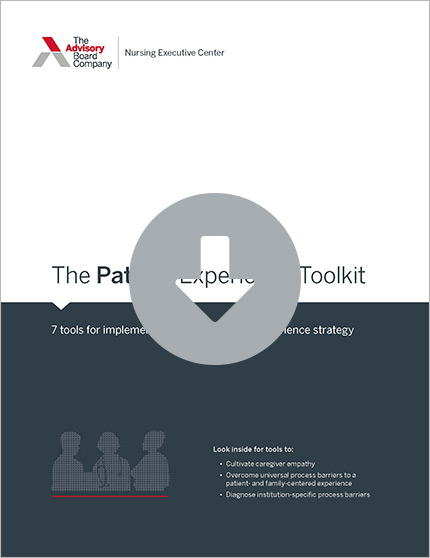
7 ready-to-use tools to improve the patient experience
'A product that everyone wants'
Q: Tom, 2018 was a remarkable year for the Clinic. In addition to your international expansion, you, you also built out existing operations in Ohio, Toronto, Las Vegas, and Florida. In total, the Clinic hosted two million patients and announced plans to more than double that number, to four million, in five years. Would you elaborate on that plan?
Mihaljevic: For any large organization, I think it's important for all employees to have a shared sense of direction, to understand what matters and how we measure what matters. At Cleveland Clinic, we want everyone in the world to have access to the best health care.
Our unique model of care and our clinical excellence provides a service that profoundly changes the lives of the people who experience it. This translates into an obligation to extend the type of care we provide to as many people as possible. So the measure of our success as an organization is the number of lives we touch and the amount of suffering we relieve.
I've always been perplexed by the fact that health care organizations do not have a mandate to grow. All Americans should have access to the best U.S. health care, and the fact that they don't is indefensible.
Q: This is a very intuitive way to think about growth when you explain it, but I haven't heard it articulated quite in that way before. You're describing growth for the Clinic as almost an ethical obligation.
Mihaljevic: It's a must. It's an ethical responsibility. I don't have an investor call every quarter. We're not shelling out dividends. The only imperative to grow is the people out there who need our help. I think it is indefensible to have a waiting list, that's why we are focusing on access.
So when people ask, "Why do you grow? Aren't you concerned about the brand?", I say, "I'm concerned about people who need our help and who cannot get it." That's our silent constituency, the people no one keeps statistics on—they are the ones we're working for and growing for.
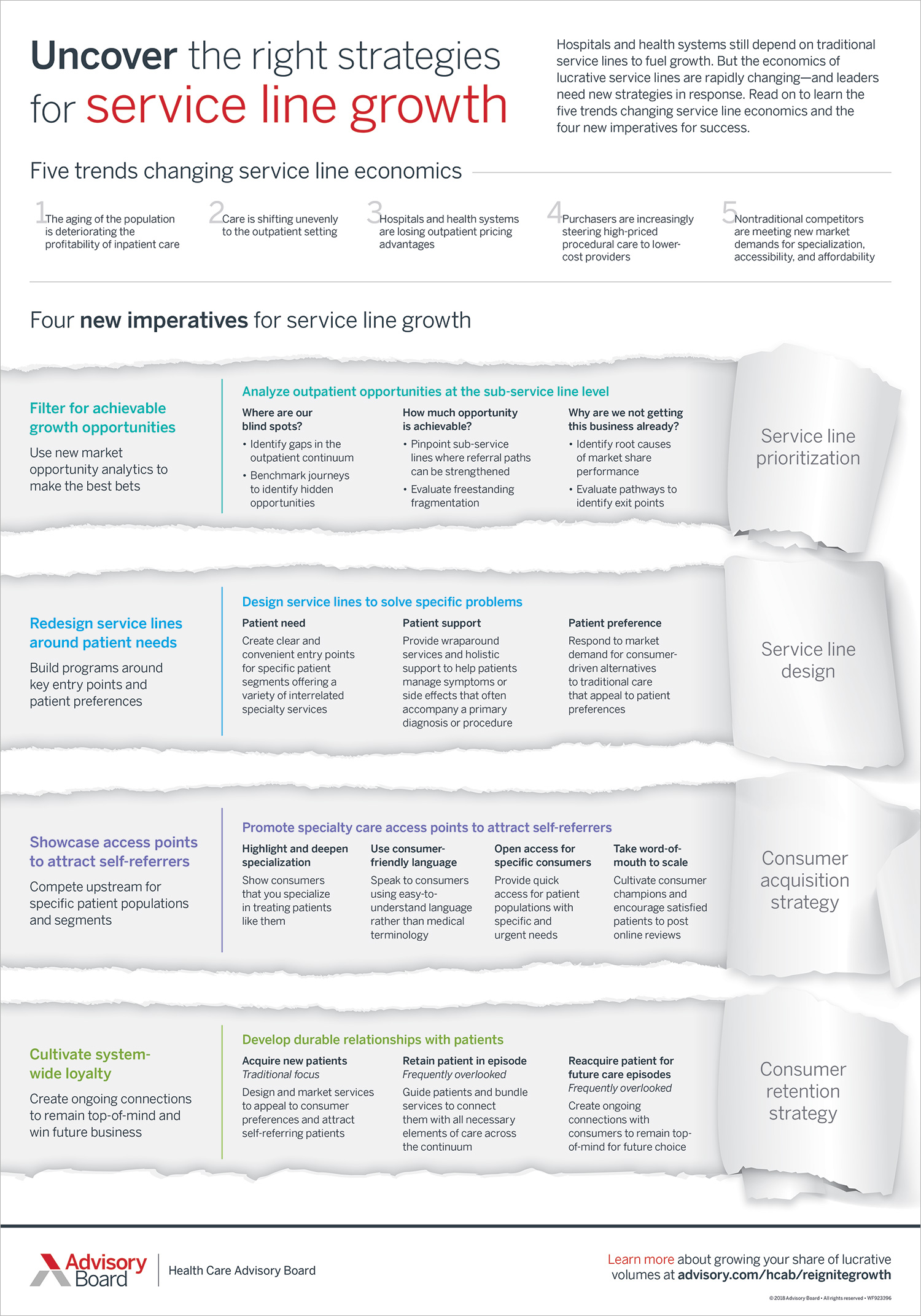
Uncover the right strategies for service line growth
Q: That resonates. And it's interesting to observe how you have accelerated different kinds of growth. For instance, you recently acquired four hospitals in Florida, after Cleveland Clinic's Weston facility there was at 120% capacity—so that's geographic and horizontal growth. And then there's the plan to double the number of patients the Clinic sees, which is inextricably tied up with digital enablement and the virtual front. How are you deconstructing your growth goals in terms of virtual access versus physical presence?
Mihaljevic: We're always looking into the conventional, horizontal growth you described, such as creating partnerships or integrating other nonprofit organizations into our system. Another venue is creating digital platforms that will allow us to share the Cleveland Clinic's knowledge exponentially, because digital platforms can grow much faster than horizontal growth. We are also looking into other forms of growth, including consulting partnerships.
Q: Let's go a bit deeper into digital and virtual. I think we can agree there's a lot of "irrational exuberance" right now in the venture capital (VC) space: valuations at record highs, with $100 billion in total VC in the United States last year, and $8.1 billion for digital health startups. Cleveland Clinic is unique in that you anticipated this run—the organization launched Cleveland Clinic Innovations in 2000, and has launched at least 70 companies, including a couple of notable successes, like Explorys, since then. So when you think about digital and virtual growth here in 2019, how are you measuring progress? How are you separating signal from noise in this space?
Mihaljevic: We're focusing on making sure that we as a Cleveland Clinic are one Cleveland Clinic, meaning we act as one health care system. We want to be one Cleveland Clinic, with the same experience and quality care for every patient in every location. And to do that, the virtual platforms are really important.
Actually, a lot of our clinical operations are already firmly in a virtual domain. For instance, we can monitor every intensive care unit bed 24/7 through our EICU, located in a bunker in Cleveland, and our Epilepsy Monitoring Unit allows us to monitor every single patient who has an EEG throughout all Cleveland Clinic locations. And that allows us to have the same quality of care in every location for these patients. On the other hand, one of our fastest-growing offerings is our telemedicine for consultations, second opinions, and so on. We've doubled in size over the last couple of years, and we see that as a huge opportunity.
While we have the intellectual capacity and content knowledge within our walls to develop digital and virtual platforms, we realize we can't do it ourselves. So we are in conversations with large companies, all of the household names in the IT space, to find partners to help us create new platforms for digital health.
Q: Let's pivot to yet a third dimension of growth—vertical integration, and strategies for aligning more closely with payers. You've launched a well-publicized partnership with Oscar, which exceeded expectations on the exchanges by attracting 11,000 lives, and you've also launched a white-label MA partnership with umana. How are these initial collaborations working?
Mihaljevic: Well, just like in any complex job, you have to decide what your core competencies are, what competencies others may have, and whether you want to develop those competencies independently or partner. We've made a conscientious decision to stick to Cleveland Clinic's unique competency—providing coordinated, safe care of the highest quality. So that's why we've never gone into the payer space, because we do not have that competency. We are, however, interested in forming partnerships in the payer space. And our experiences with some of the newer ventures have been very positive.
There is one feature in particular that I think will fundamentally change how providers and payers collaborate, and that is the availability of longitudinal data on outcomes, cost, and other data—essentially the value of the care that you provide. Let me explain that: Patients used to be referred to hospitals or other practitioners by their doctors, but then things shifted with the internet, when patients began researching and referring themselves. And what we're seeing now is probably the biggest shift: Patients are going to be payers, which means they're no longer looking at providers through the lens of the cost of an episode of care—they're looking through the much broader lens of the value and longitudinal cost of care. And all of us are learning that the overall cost of care is what really matters for individuals, their families, and society.
So we're now seeing large payers who've realized that there are only very few locations in the United States where certain types of care can be adequately provided. And I believe it's inevitable that those large payers will rightfully channel patients for complex care to those locations.
Artificial intelligence, machine learning and robotic process automation at Cleveland Clinic
Q: Cleveland Clinic recently launched its Center for Clinical AI, and among the first announced projects are the development of advanced algorithms to help more accurately diagnose and treat lung and breast cancer. Obviously, there's a lot of excitement in this space at the moment, with some extraordinary early advances led by companies such as Buoy and Babylon. I would love your perspective on sifting fact from fiction in AI, machine learning (ML), and robotic process automation (RPA).
Mihaljevic: You know, Eric, everybody's talking about AI, but I think the importance of AI in health care is perhaps overemphasized compared to what it's currently offering us. Because while AI is certainly important, there are many more tools that, while less interesting to talk about, can have a substantially greater, more immediate impact on health care delivery and care quality.
Now, for obvious reasons, we've invested in AI and ML. We already have certain products in daily practice, such as an ML algorithm to predict which patients have a greater likelihood of readmissions. And we're curious about what ML and AI can do in the cancer space, as you mentioned. I think another AI opportunity that could really transform health care is voice recognition—the sooner we can get away from keyboards as a major tool for health care delivery, the better off we are. So the list goes on and on.
But I'm equally intrigued by a digital infrastructure that could help the day-to-day management of a large integrated health care delivery system like ours. So as an example, let's say Cleveland Clinic doubled its size from 200 care delivery sites to more than 400 within a year. How do you coordinate all of that? We don't have a digital infrastructure that helps us to allocate our resources, people, space, and time in concordance with our patients' needs, and there are care disruptions as a result. So we're passionate about finding digital solutions that will enable us to use our resources more effectively. So when we look at digital partnerships, we're looking for a much more comprehensive package than just AI.
And I think any health care organization should look at its data, data management, and informatics management, because that's becoming core to the business now—we have to learn how to organize ourselves to better oversee, govern, and protect our data. Because I believe the data part of the health care business, which is just in its nascency now, will completely change the traditional form and format of large health systems like ours. You know, we typically have had institutes that take care of different organs and organ systems. Now, we're going to have a part of the organization to take care only of that information and information data. And we'll need to have a different type of health care professional as well.
Wrapping up
Q: Before we wrap up, I'd like to ask about the state of our caregivers and the national epidemic of clinician burnout. It was striking to me that when you recently gave the annual ""state of the union"" for the Clinic, you articulated patient safety and outcomes first, and then immediately talked about the state of the Clinic caregivers. In fact, I believe you're the first health system in the country to go so far as to establish an Office of the Caregiver Experience.
Webinar series: How to succeed in the workplace
Wednesday, Oct. 16
Advocate for yourself
Thursday, Oct. 24
Prioritize your workload
Wednesday, Oct. 30
Engage your staff
Mihaljevic: It's very important. The purpose of Cleveland Clinic is to be not just the best place to receive health care, but also the best place to work in health care—you cannot have one without another. And also, we're a caregiver-led organization; all of our employed physicians are on one-year contracts. I've renewed my contract 16 times. I hope to do it a 17th time. So for us, in contrast to many other organizations where physicians or nurses may be employed by an entity, the caregiver experience is our experience; we are the entity.
So we've embarked on a very analytical approach to understand and address the reasons for burnout. And what we found was interesting: Among our colleagues in nursing, some of the biggest stressors were a lack of good food options after hours in a hospital and not having enough daylight in your workplace—that's really important when you work long hours. But for our physicians, it's a lack of flexibility in their schedule, figuring out how to balance work and family. So every segment of our caregivers has very unique needs, which means that many of our solutions will have to be tailored to various parts of the enterprise.
But across the board, the one core ingredient that's key for successfully addressing burnout is to work as a team. You cannot cope with everything that's coming at you every single day as an individual. You can cope, however, if you share those burdens and challenges with people around you, and if you work as a team to find a path forward. And at Cleveland Clinic, we have an organizational model where we're all one, so while it's very complex, it's much easier for us to do. And we'd rather focus on finding the organizational structure that will help us address not only today's problems, but also future problems.
Q: I agree that this team-based clinical model will absolutely be a part of the solution. Perhaps you could talk about that in the context of your new $500 million,485,000 square-foot Health Education Campus that you're opening with Case Western Reserve University. What is most remarkable to me about this project is the interdisciplinary nature of the architectural and curriculum—under one roof, you have medical, dental, nursing, and PA students.
Mihaljevic: Well, it just translates the team-based concept that we're so passionate about when we speak about the contemporary workforce. We want to translate that into education as well; you want to teach people how to work together as a team from the very beginning, so they do not get lost in the process as they enter the workspace.
Because one of the real issues in the health care workforce is that we're traditionally trained as soloists, but the industry today is an orchestra. And it's really difficult for people who are trained as soloists—and whose heroes were soloists—to know how to play well in the orchestra. So you have to find a balance where you understand the benefits of being in the orchestra while also appreciating individual contributions.
Q: You've been transparent about your profound appreciation for all the extraordinary opportunities in your life, and I'm curious: As you think back on your journey here, what are you most grateful for?
Mihaljevic: I never, ever thought that I would have the opportunities, the job, or the privileges that I enjoy today.
And I'm very grateful for the people along the way who made it possible for me. I don't know if I'll ever be able to repay them, but I always try to stay in touch with those who've mentored and helped me. Because by no means do I assume that what I have today is a reflection of my abilities; it's a result of the graciousness of many people with whom I was fortunate to interact. We've both done what we've done because we are in the company of really good people for a really long time. So if you're not grateful, you're missing something—and now, it's my turn to give back to those who are following the same path.
Q: And my last question: As you think about all the things that are underway at the Clinic, what are you most passionate about right now?
Mihaljevic: I'm really passionate about this combination of things we spoke about, especially our mission to touch as many lives as possible, and finding the solution that will establish Cleveland Clinic as the best place to work in health care. That's my job in a nutshell; I'm responsible to make sure that the Cleveland Clinic delivers the best and safest care possible and serves as the best place to work in health care. I think we are well under way.
Get more lessons from the C-suite
Check out Eric's recent must-read interviews with top hospital and health system leaders:
From Ascension to Intermountain and now 'home' at SSM Health: How Laura Kaiser is 'systematizing' mission-based care
Laura Kaiser, president and CEO of SSM Health, talks about the call to nonprofit health care, SSM Health's legacy of caring for ""Our Dear Lords, and why she's completed at least one triathlon almost every year—for the last 36 years. Read our interview with Laura.
Marc Harrison promised to turn Intermountain into a 'Tesla.' He wasn't kidding.
Marc Harrison, president and CEO of Intermountain Healthcare, talks about Intermountain's recently announced strategic reorganization, previews the launch of a ""virtual hospital"" to better serve rural communities, and shares the surprising worry that keeps him up at night. Read our interview with Marc.
'A little bit of a pirate': How Kelby Krabbenhoft built a $6B system—and where he's taking Sanford next
Kelby Krabbenhoft, president and CEO of Sanford Health, talks about the unprecedented CEO-philanthropist partnership behind Sanford's rapid growth, why a successful leader needs to be ""a little bit of a pirate, and the merger that will make Sanford a nearly $6 billion health system. Read our interview with Kelby.
Subscribe to At the Helm
To get more of our top insights for CEOs and other C-suite executives, make sure you're subscribed to the ""At the Helm"" blog.
"
Don't miss out on the latest Advisory Board insights
Create your free account to access 1 resource, including the latest research and webinars.
Want access without creating an account?
You have 1 free members-only resource remaining this month.
1 free members-only resources remaining
1 free members-only resources remaining
You've reached your limit of free insights
Become a member to access all of Advisory Board's resources, events, and experts
Never miss out on the latest innovative health care content tailored to you.
Benefits include:
You've reached your limit of free insights
Become a member to access all of Advisory Board's resources, events, and experts
Never miss out on the latest innovative health care content tailored to you.
Benefits include:
This content is available through your Curated Research partnership with Advisory Board. Click on ‘view this resource’ to read the full piece
Email ask@advisory.com to learn more
Click on ‘Become a Member’ to learn about the benefits of a Full-Access partnership with Advisory Board
Never miss out on the latest innovative health care content tailored to you.
Benefits Include:
This is for members only. Learn more.
Click on ‘Become a Member’ to learn about the benefits of a Full-Access partnership with Advisory Board
Never miss out on the latest innovative health care content tailored to you.

